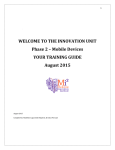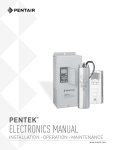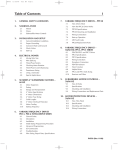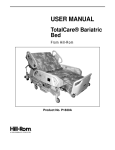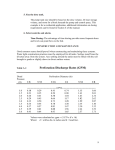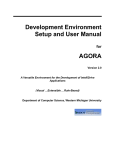Download VersaCare® Bed Quick Reference Guide
Transcript
VersaCare® Bed Quick Reference Guide Bed Features Item Description Page A Emergency CPR and Emergency Trendelenburga Control 3 B Battery Control 4 C Foot Controls 5 D Point-of-Care® Caregiver Control Panel 5, 6 E Control Pod 7, 8, 11 F IntelliDrive® Transport System (optional) 9 G Active Integrated Response® Treatment Surface (optional) 11 E D A B a. There must be power to the bed, either AC or battery, for the Emergency Trendelenburg function to operate. C F G NOTE: In this document, there are references to different bed models. To identify your bed model, look at the serial number label. The label is on the right side of the weigh frame, under the patient’s shoulder. For example, P3200AXXXX identifies an A model bed. Also in this document where two versions of a symbol are shown, one or the other will be used on your bed. Page 2 of 16 For detailed Warning and Caution statements, and operating instructions, refer to the VersaCare® Bed User Manual (USR119). For detailed Warning and Caution statements, and operating instructions, refer to the VersaCare® Bed User Manual (USR119). Emergency CPR Emergency Trendelenburg Safety and Information Indicators The emergency CPR controls are handles located under the sleep deck, between the head and intermediate siderails on both sides of the bed. NOTE: The headboard can be used as a CPR board. 1. Pull and hold the CPR handle. If the bed has an air mattress, the mattress will go into Max-Inflate. The emergency Trendelenburg controls are handles located under the sleep deck, between the head and intermediate siderails on both sides of the bed. The handles used to operate CPR are also used to operate emergency Trendelenburg. NOTE: There must be power to the bed, either AC or battery, for the Emergency Trendelenburg function to operate. 1. Make sure the bed is plugged into AC power or the battery is activated. NOTE: There must be power to the bed, either AC or battery, for the indicators to operate. NOTE: A through F models have the Service is Required indicator only. 2. Hold the CPR handle until the head and knee section come to a stop in the flat position. 3. Release the CPR handle. 2. Pull and hold the CPR handle. 3. Hold the CPR handle until the head and knee section come to a stop in the flat position. 4. Continue to hold the CPR handle until you reach the applicable bed angle. 5. Release the CPR handle. Disconnected from AC Power If the bed is disconnected from AC power and the battery is active, the plug indicator flashes. Service Is Required When the system determines the bed or air surface operation is not correct, the wrench indicator comes on solid or flashes. Contact your facility-authorized maintenance person. Battery Charge is Required When the battery charge is low, the Battery indicator flashes. Plug the bed into AC power as soon as possible. Brake Not Set If the bed is connected to AC power, and the brake is not set, the Brake Not Set indicator (available on some beds) flashes and a continuous alarm comes on. Set the brake to stop the alarm. Emergency CPR and Trendelenburg and Safety and Information Indicators Bed Page 3 of 16 Bed Obstacle Detection and Battery and Foot Controls Obstacle Detection Battery Control The bed is equipped with an obstacle detection system that runs along the three open sides of the base frame. This system detects objects that are between the upper frame and the base frame. If an object is detected, the Bed Not Down indicator on both siderails will flash and you will not be able to lower the bed. If an object is detected while the bed sleep deck is lowering, the bed will stop lowering, and then raise automatically for 2 seconds. The Bed Not Down indicator on both siderails will flash. The Battery control is at the head end of the bed, on the right side, under the headboard, just below the power cord. • The battery stays active for 10 minutes after the last control is activated. NOTE: For more information about battery operation with the Bed Exit System or the 30° Head Angle Alarm, see page 7. Foot Controls 1. To enable the controls, step down on one of the Head Down/Up or Bed Down/Up pedals for 1 to 3 seconds. NOTE: If the battery is fully charged, the battery indicator will be on. If the battery charge level is low, the batter indicator will flash. If the battery indicator is off, the battery may have lost all of its charge or it may need to be activated. To charge the battery, plug the bed into an applicable power source. 2. Release the pedal. 3. Step down on the pedal of the applicable function until the bed is in the correct position. Activate Press the Battery control. • The functions on the caregiver control panel are available. • The functions on the control pod are not available, and the surface indicators will be off. Page 4 of 16 Bed Down/Up Head Down/Up For detailed Warning and Caution statements, and operating instructions, refer to the VersaCare® Bed User Manual (USR119). For detailed Warning and Caution statements, and operating instructions, refer to the VersaCare® Bed User Manual (USR119). Enable Control Caregiver Control Panel Controls A through F models—the control is on both the caregiver control panel and control pod. You must press the Enable control to use the controls outside of the caregiver control panel’s blue section and all controls on the control pod. G model and newer—the control is on the control pod only. You must press the Enable control to use the controls in the green sections of the control pod. NOTE: The siderail Enable controls do not enable the Foot pedal controls. 1. Press the Enable control. The indicator comes on. The Enable control is active for 60 seconds. Chair 2. During the 60-second period, press the applicable caregiver control. The 60-second period starts over each time you press another control. 1. Set the brake. 2. A through F models, press the Enable control. G model and newer, go to step 3. 3. Press and hold the Chair control until the patient deck goes into the chair position. NOTE: Use the reverse Trendelenburg control for an additional 10° of forward chair angle. Bed Flat A through F models—the Bed Flat control returns only the sleep deck to the flat position; it does not change the angle of the bed. G model and newer—the Bed Flat control returns the sleep deck and bed to the flat and level position. 1. A through F models, press the Enable control. G model and newer, go to step 2. Enable, Chair, Bed Flat, and Foot Length Controls Bed 2. Press and hold the Bed Flat control until all sections are flat and the system stops. Foot Extend/Longer and Foot Retract/ Shorter 1. A through F models, press the Enable control. G model and newer, go to step 2. 2. Press and hold the applicable Foot Extend/Longer or Foot Retract/Shorter control until the bed is at the applicable position. Page 5 of 16 Bed Boost® Position and Lockout Controls Boost® Position System (G model and Newer When you activate the Boost® Position System, the bed will go to a mid-height and flat and level position. If you continue to hold the control for 5 more seconds, the bed will adjust to 7° Trendelenburg. If an air surface is installed, the surface will go into Max-Inflate for 30 minutes unless the Boost® function is deactivated. NOTE: The Boost® Position is contraindicated for some patients. Follow your facility's protocols when you adjust the patient’s position, and refer to Warnings and Contraindications on page 14. 1. Press and hold the Boost® Position control: • Release the control when the bed is at the flat and level position. Or • If Trendelenburg is not contraindicated for your patient, hold the control for 5 seconds longer for the bed to go into the 7° Trendelenburg position. 3. To disengage the Boost® function, press any of the bed function controls except these: Boost® System, Bed Up/Down, or Trendelenburg. Lockout Control—G Model and Newer Lockout Controls—A through F Models Activate At the same time, press and hold the Enable control and the applicable Lockout control. An indicator comes on when a lockout is activated. The indicator will stay on until the lockout is deactivated. All Motors Head Bed Knee Up/Down Up/Down Up/Down Deactivate At the same time, press and hold the Enable control and the locked out control until the indicator goes off. Activate At the same time, press and hold the Lockout control and the direction control of the applicable function. An indicator and an alarm come on when a lockout is activated. The indicator will stay on until the lockout is deactivated. NOTE: When you activate the lockout for either the knee up/down or foot longer/shorter control, both knee up/down and foot longer/shorter functions will be locked out. Deactivate At the same time, press and hold the Lockout control and the locked out function control until the indicator goes off. 2. Move the patient to the head of the bed as necessary. Page 6 of 16 For detailed Warning and Caution statements, and operating instructions, refer to the VersaCare® Bed User Manual (USR119). For detailed Warning and Caution statements, and operating instructions, refer to the VersaCare® Bed User Manual (USR119). Bed Exit Alarm System The Bed Exit controls are on the control pod on the head-end siderails. Patient Position Bed Exiting Out-of-Bed Activate 1. Make sure the patient is not on the bed. 2. Zero the scale. 3. Put the patient in the center of the bed and aligned with the hip locator. 4. Press the Enable control. 5. Press the applicable Bed Exit mode control. When the system beeps one time and the indicator stays on solid, the system is armed. If the system does not arm, the system will beep rapidly for a few seconds and the selected mode indicator will flash. This means: the patient weighs less than 70 lb (31.8 kg) or more than 500 lb (227 kg); the patient is not in the correct position; or the system has malfunctioned. NOTE: If a Bed Exit mode is active and the bed gets unplugged or the battery activated, the Bed Exit Alarm System will be inactive. When the bed is plugged in again, the Bed Exit mode will activate at the previous setting. NOTE: When there is a Bed Exit alarm condition, the applicable mode indicator will flash and you will hear an alarm. To turn off the alarm sound, you must deactivate the Bed Exit Alarm System. Deactivate At the same time, press and hold the Enable control and any Bed Exit mode control until the indicator goes off. 30° Head Angle Alarm (G Model and Newer) The 30° Head Angle Alarm control is on the control pod on the head-end siderails. Activate 1. Raise the head section to the applicable position above 30°. 2. Press the Enable control. 3. Press the Alarm control. The indicator comes on and will stay on until the alarm is deactivated. NOTE: When the bed operates on battery power and the alarm is set, if the head section goes below 30°, an audible alarm will come on and the alarm indicator will flash. The display on the control pod will be off. Turn Off the Alarm Raise the head section above 30°. Deactivate 1. Press the Enable control. 2. Press the Alarm control. The indicator will go off. Bed Exit and 30° Head Angle Alarm Bed Page 7 of 16 Bed Scale Scale Zero the Scale Weigh the Patient The scale display and controls are on the control pod on the head-end siderails. The scale must be zeroed before the patient is put on the bed. 1. Put all linens, pillows, and equipment on the bed. 1. A through F models, press the Enable control. G model and newer, go to step 2. 2. Make sure the patient is not in the bed. 3. Press the Enable control. NOTE: On some bed models, it is necessary to press the Enable control to use the scale controls. 1. Make sure the bed is plugged into electrical power. 2. Put all linens, blankets, pillows, equipment, and standard items on the bed. 2. Press the Weigh control. The bed shows the current patient weight on the display. 4. Press and hold the Zero control until 00.0 shows on the display (HOLD will show until 00.0 shows). NOTE: After you release the Zero control, the display will flash CALC. Do not touch the bed until the display shows 0.0. 3. Make sure none of the items on the bed touch the headboard. 4. Make sure the bed does not touch anything that could affect the patient weight (headwall, lines such as pendant controls, ventilators, or drainage bags). 5. Make sure the patient is not in the bed. 6. Zero the scale. Page 8 of 16 For detailed Warning and Caution statements, and operating instructions, refer to the VersaCare® Bed User Manual (USR119). For detailed Warning and Caution statements, and operating instructions, refer to the VersaCare® Bed User Manual (USR119). IntelliDrive® Transport System 1. Raise all siderails to the up and locked position. 7. Press one or both of the Enable switches on the transport handles. tral or Brake, and plug the bed into an applicable power source. 2. Secure all equipment being transported with the bed (monitors, IV poles, and such). 3. Adjust the bed’s position to make sure your view is unobstructed. 4. Unplug the bed power cord and, if installed, the auxiliary outlet power cord from their power source. 5. Set the Brake/Steer control to Steer Neutral 8. While you press the Enable switches, push the transport handles forward or pull them backward for the applicable direction. 9. To stop, release the handles. 6. Hold one or both transport handles at the head end of the bed. NOTE: In case of battery or motor power loss, press the electronic brake switch to the Off position to permit forward and reverse bed movement with a deployed, unpowered IntelliDrive® Transport System. The electronic brake switch is on the right side of the bed, near the foot pedal controls. 10. If the bed is to be left unattended, set the brake. Steer Brake 11. Stow the handles when the transport is complete. 12. Plug the bed into AC power. 13. To deactivate the IntelliDrive® Transport System, set the Brake/Steer control to Neu- On/Off Switch IntelliDrive® Transport System Bed Page 9 of 16 Bed Troubleshooting NOTE: If the troubleshooting information shown below does not fix the problem, contact your facility-authorized maintenance person. The Bed Does Not Work Make sure the bed is plugged into AC power or the battery is active. For battery information, refer to “Battery Control” on page 4. The Service Is Required (Wrench) Indicator Is On or Flashing When the system determines the bed or air surface operation is not correct, the wrench indicator comes on solid (bed error) or flashes (air surface error). Contact your facility-authorized maintenance person. The Bed Controls Do Not Work • Make sure the bed is plugged into AC power or the battery is active. • Make sure the lockouts are deactivated. See page 6 to deactivate them. NOTE: If all lockout indicators and the service required indicator are on, contact your facilityauthorized maintenance person. Page 10 of 16 The Bed Does Not Lower The Display on the Control Pod Is Off Make sure of these: • The bed is plugged into AC power or the battery is active. • The Bed Down control is not locked out. • The Bed Not Down indicator is not flashing. • There is nothing between the upper frame and the base frame. • There is nothing between the obstacle detect sensors on the base frame. • The obstacle detect covers, located in the caster covers, are installed correctly. Make sure the bed is plugged into AC power. When the bed operates on battery power, the display will be off. NOTE: If the bed has the 30° Head Angle Alarm option and the alarm is set, if the head section goes below 30°, the audible alarm will come on and the Head Angle Alarm indicator will flash. The Foot Controls Do Not Work Make sure of these: • The bed is plugged into AC power or the battery is active. • The lockouts are deactivated. • You have enabled the foot controls. Refer to “Foot Controls” on page 4. The Display on the Control Pod Flashes when a Weight Is Taken The maximum weight the scale will show has been exceeded. The Head Section Angle Appears to be much different than the Head Angle Display Shows (G model and newer beds) Contact your facility-authorized maintenance person. The Bed Exit Alarm Does Not Arm and All Three Mode Indicators Are Flashing Remove the patient, and zero the Bed Exit system. See “Bed Exit Alarm System” on page 7. For detailed Warning and Caution statements, and operating instructions, refer to the VersaCare® Bed User Manual (USR119). For detailed Warning and Caution statements, and operating instructions, refer to the VersaCare® Bed User Manual (USR119). Active Integrated Response® Treatment Surface The controls for the Active Integrated Response® Treatment Surface are on the control pod. You must press the Enable control to use the surface controls. Pressure Relief/Normal Activate 1. Press the Enable control. 2. Press the Pressure Relief/Normal control. An indicator will come on when the mode is active. Max-Inflate Heel Relief Max-Inflate mode causes the sleep surface to become very firm. After 30 minutes, if no other mode is selected, the surface automatically returns to the Pressure Relief/Normal mode. NOTE: If the surface is in Max-Inflate mode and the bed gets unplugged, the surface will stay in Max-Inflate mode. When the bed is plugged in again, the surface will go into Pressure Relief/ Normal mode. Activate 1. Press the Enable control. For the patient to get heel relief, extend or retract the bed foot section to align the patient's heels in the heel relief zone. NOTE: The Foot Extend/Longer and Retract/ Shorter controls are on the caregiver control panel. Activate 1. A through F models, press the Enable control. G model and newer, go to step 2. 2. Press the Max-Inflate control. An indicator will come on when the mode is active. Deactivate 1. Press the Enable control. 2. Press and hold the Foot Extend/Longer or Retract/Shorter control to move the foot section in or out. 2. Press the Pressure Relief/Normal control. Pressure Relief/ Normal, Max-Inflate, and Heel Relief Air Surface Page 11 of 16 Air Surface Turn Assist and Sleep Mode Turn Assist The turn assist bladder inflates and rotates the patient approximately 20°, which takes about 30 seconds. The system will hold the pressure for ten seconds. After ten seconds, an alarm sounds, the turn assist bladder deflates and returns to Pressure Relief/Normal mode. NOTE: If a siderail is lowered during Turn Assist operation, a brief alarm will sound and the Siderail Not Up indicator will come on. Activate 1. Make sure the head angle is below 25°. 2. Make sure the siderails are in the up and locked position on the side the patient is turning towards. Turn assist will not start until the siderails are up. 3. Press the Enable control. 4. Press the Left Turn or Right Turn control. The indicator will come on. NOTE: If the siderails are not in the correct position or the head section is not below 25°, an indicator will flash and an alarm will sound. Deactivate. 1. Press the Enable control. 2. Press the opposite Turn control, Pressure Relief/Normal control, or Max-Inflate control. Sleep Mode Left Turn Right Turn The Sleep Mode is used to minimize the frequency of air system adjustments to allow patients who are sensitive to sleep surface movement to sleep. The air pressure in the mattress is monitored, but the air pump does not run unless the air pressure falls below or raises above a preset level. Activate 1. Press the Enable control. Pressure Relief/ Normal Max-Inflate 2. At the same time, press and hold the Left Turn and Right Turn controls for 5 seconds. After 5 seconds, the Left and Right Turn indicators will come on. Deactivate The bed will automatically return to Pressure Relief/Normal mode after 3 hours or 8 hours (on some bed models) or if it is necessary to adjust the mattress pressure. or 1. Press the Enable control. 2. Press any air system control. The applicable control indicator will come on. Page 12 of 16 For detailed Warning and Caution statements, and operating instructions, refer to the VersaCare® Bed User Manual (USR119). For detailed Warning and Caution statements, and operating instructions, refer to the VersaCare® Bed User Manual (USR119). NOTE: If the troubleshooting information shown below does not fix the problem, contact your facility-authorized maintenance person. The Service Is Required (Wrench) Indicator Is Flashing When the system determines the bed or air surface operation is not correct, the wrench indicator comes on solid (bed error) or flashes (air surface error). Contact your facility-authorized maintenance person. The Surface Does Not Inflate or Does Not Inflate Correctly Make sure of these: • The bed is plugged into AC power. • The Service Is Required indicator is not flashing. • You press the Enable control before you press the applicable mattress function. • The mattress retaining straps at the head and foot ends of the bed are installed in their retainers. Turn Assist Does Not Work • Make sure of these: • The bed is plugged into AC power. • The siderails that the patient is turning toward are in the up and locked position. • The head section is below 25°. • You press the Enable control before you press the applicable Turn Assist Mode control. The Surface Mode Indicators are Flashing 1. Unplug the bed, and wait for 10 seconds. 2. Plug the bed into an applicable power source. Retainer Retaining Strap Page 13 of 16 Troubleshooting Air Surface Warnings and Contraindications Evaluate patients for entrapment risk according to facility protocol, and monitor patients appropriately. Make sure all siderails are fully latched when in the raised position. Failure to do either of these could cause serious injury or death. Relative Contraindication for beds with an air surface—use of active therapy surfaces with patients with unstabilized spinal cord injury could cause serious injury to the patient. Beds with the Boost® Position System—do not use the Boost® function if there are concerns of spinal instability. To do so could cause patient injury. We recommend that you do not transport a patient when the bed is in the Chair or Boost® positions. And, use caution if you transport a patient when the bed is in the Trendelenburg or Reverse Trendelenburg positions. IV pole use—the head-end equipment sockets do not move up and down with the sleep deck. Use applicable precautions with gravity-sensitive devices such as ventricular drains or lumbar drains before, during, and after you operate the bed functions. Make sure flow rates on all gravityfed IVs are correct after you adjust the bed height. Failure to correctly manage patient equipment could cause patient injury. Page 14 of 16 Make sure the bed is in the low position when the patient is unattended. This can reduce the possibility of patient falls and the severity of any resultant injuries. NOTE: Whenever the bed is not in its low position, the Bed Not Down indicator will be on. Bed with an auxiliary outlet—do not plug both power cords into the same wall receptacle. Plug the power cords into different receptacles on separate circuits. Failure to do so can cause equipment damage or tripping of facility power breakers. Do not use the accessory receptacle for life support equipment. Plug life support equipment directly into facility power supply. Beds with the IntelliDrive® Transport System—if the bed moves forward or reverse unintentionally, contact your facility-authorized maintenance person. Failure to do so can cause personal injury or equipment damage. Beds with the Line Managers—do not use the Line Manager for ventilator circuits. To do so could cause patient injury. For detailed Warning and Caution statements, and operating instructions, refer to the VersaCare® Bed User Manual (USR119). For detailed Warning and Caution statements, and operating instructions, refer to the VersaCare® Bed User Manual (USR119). Patient Weight 500 lb (227 kg) maximum Safe Working Load (includes patient weight, mattress, IV pumps, poles, bags, traction equipment, and such) 550 lb (250 kg) Active Integrated Response® Treatment Surface—Patient Characteristics 500 lb (227 kg) 475 lb (215 kg) for effective pressure redistribution Width up to 35" (89 cm), and/or a height between 59" and 84" (150 cm to 213 cm). Page 15 of 16 Patient Characteristics © 2008 by Hill-Rom Services, Inc. ALL RIGHTS RESERVED. No part of this text shall be reproduced without written permission from Hill-Rom Services, Inc. Active Integrated Repsonse® is a registered trademark of Hill-Rom Services, Inc. Boost® is a registered trademark of Hill-Rom Services, Inc. Hill-Rom® is a registered trademark of Hill-Rom Services, Inc. IntelliDrive® is a registered trademark of Hill-Rom Services, Inc. NaviCare® is a registered trademark of Hill-Rom Services, Inc. Point-of-Care® is a registered trademark of Hill-Rom Services, Inc. VersaCare® is a registered trademark of Hill-Rom Services, Inc. DS142 REV 3/April 2008 Rental: 800-638-2546 USA: 800-445-3720 www.hill-rom.com Canada: 800-267-2337 International: 812-934-8173


















